Automotive Lubricants Market Research, 2032
The global automotive lubricants market was valued at $77.8 billion in 2022, and is projected to reach $116.1 billion by 2032, growing at a CAGR of 4.1% from 2023 to 2032.
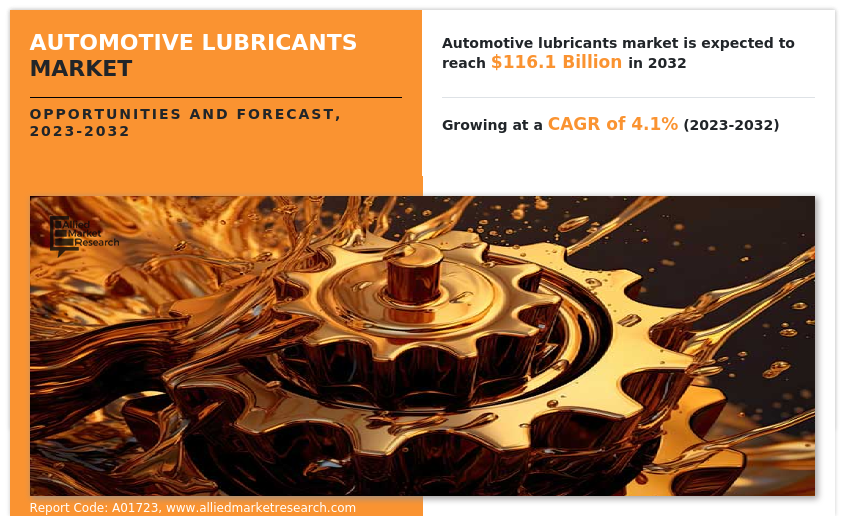
Introduction
Automotive lubricants are specially formulated substances used to reduce friction, wear, and heat between moving parts in vehicles, ensuring smooth operation and enhanced performance. They include engine oils, transmission fluids, gear oils, greases, and coolants, each designed to serve specific functions in different vehicle components. These lubricants help extend the lifespan of engine and transmission systems by minimizing metal-to-metal contact, preventing corrosion, and maintaining optimal temperature control. Modern automotive lubricants are often enhanced with additives to improve viscosity, thermal stability, and resistance to oxidation, meeting the stringent requirements of contemporary vehicle technologies, including electric and hybrid models.
Report Key Highlighters:
- The automotive lubricants market is fragmented in nature with few players such as include Royal Dutch Shell Plc., Fuchs Lubricants, Bp Plc., Total S.A., Indian Oil Corporation Limited, Chevron Corporation, Valvoline, Petrochina Company Limited, And Exxon Mobil Corporation, which hold a significant share of the market.
- The report provides complete analysis of the market status across key regions and more than 15 countries across the globe in terms of value ($ Million).
- Top winning strategies are analyzed by performing a thorough study of the leading players in the automotive lubricants market. Comprehensive analysis of recent developments and growth curves of various companies helps us to understand the growth strategies adopted by them and their potential effect on the market.
- The report provides competitive dynamics by evaluating business segments, product portfolios, target market revenue, geographical presence and key strategic developments by prominent manufacturers.
Market Dynamics
Automotive lubricant is a specialized fluid designed to reduce friction and wear among moving parts in an automobile's engine and other mechanical components. These lubricants are essential for proper functioning and longevity of a vehicle's engine & various systems. Different types of automotive lubricants are available in the market such as engine oil, differential fluid, brake fluid, and others.
The global automotive industry has seen steady growth in vehicle production and ownership. As more vehicles are manufactured and purchased, the demand for lubricants used in engines, transmissions, and other vehicle components has increased.
The overall age of vehicles on the road has increased in many regions. Older vehicles often require more maintenance, including regular oil changes and lubricant replacements, which drives demand for automotive lubricants.
Improper handling, maintenance, or disposal of used lubricants lead to oil leaks and spills, which contaminate soil and water sources, harming the environment. The disposal of used motor oil and other lubricants is an environmental concern if not done correctly. Recycling and proper disposal are critical to prevent pollution. During combustion in the engine, some lubricants release emissions, including volatile organic compounds (VOCs) and particulate matter, which contribute to air pollution.
On the contrary, the global vehicle fleet continues to expand, especially in emerging markets. As more vehicles are on the road, the demand for automotive lubricants for regular maintenance and repair purposes has increased. Automotive manufacturers continually develop more fuel-efficient and high-performance engines. These advanced engines often require specialized lubricants designed to meet their specific needs. Lubricant manufacturers capitalize on this by producing advanced, high-performance lubricants. These factors are anticipated to offer remunerative opportunities for the automotive lubricants market during the forecast period.
The automotive lubricants market is segmented on the basis of base oil, vehicle type, application, and region. By base oil, the market is categorized into mineral oil, synthetic, semisynthetic, and bio-based lubricants. On the basis of application, the market is classified into engine oil, gear & brake oil, transmission fluids, greases, and others. By vehicle type, it is divided into passenger cars, light commercial vehicles (LCVs), heavy commercial vehicles (HCVs), and others. Region-wise, the market is studied across North America, Europe, Asia-Pacific, and LAMEA.
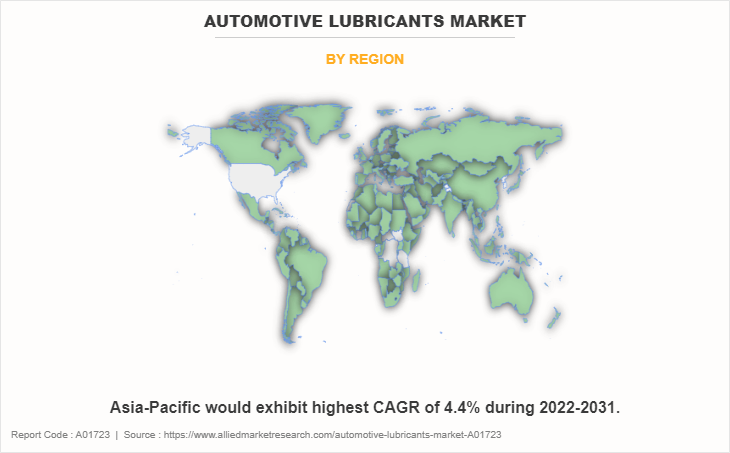
The Asia-Pacific automotive lubricants market accounted for a major market share in 2022 with 40% share in the global market and is projected to grow at the highest CAGR during the forecast period and. Increasing population-driven electricity consumption, expanding industrial expansion, and increased demand for automobiles are the region's primary drivers. The Asia-Pacific automotive lubricants market is anticipated to expand during the forecast period.
India, China, and Japan are anticipated to contribute considerably to the Asia-Pacific automotive lubricants market. In addition, population growth-driven increases in power consumption, industrial expansion, and demand for electric and hybrid automobiles are anticipated to stimulate regional market growth.
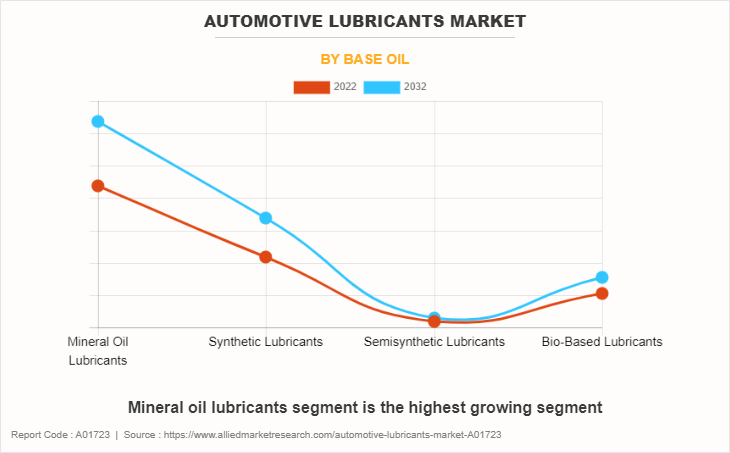
In 2022, the mineral oil lubricants segment was the largest revenue generator, and is anticipated to grow at a CAGR of 56% during the forecast period. This is attributed to the fact that. mineral oil lubricants automotive lubricants market accounted for a major market share in 2022 with 56% share in the global market and is projected to grow at the highest CAGR during the forecast period and. There is growing interest in reducing the environmental impact of automotive lubricants.
Mineral oil lubricants are derived from fossil fuels and contribute to carbon emissions. As a result, manufacturers are developing low-viscosity mineral oil lubricants that improve fuel efficiency and reduce emissions. Furthermore, some consumers are becoming more environmentally conscious and are choosing lubricants that align with their sustainability goals. This shift in consumer behavior is expected to influence the demand for alternative lubricants.
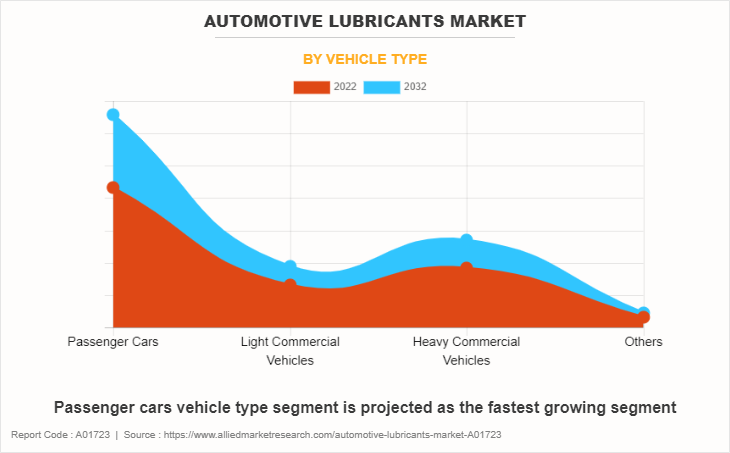
By vehicle type the market is divided into passenger cars, light commercial vehicles, heavy commercial vehicles, and others. The passenger vehicle segment is dominating the global market, in terms of revenue in 2022 with 56% share in the global market. This is attributed to the, Development and improvement of road networks, highways, and transportation infrastructure contribute to the convenience and accessibility of passenger cars. Better infrastructure encourages car ownership and usage.
Passenger cars offer convenience and flexibility, allowing individuals and families to travel comfortably and at their own pace. This is especially important as people seek to balance work, leisure, and family needs. Automotive lubricants is employed to protect frame components and suspension parts, such as control arms and stabilizer bars. These parts are critical for the vehicle's performance and safety, and automotive lubricants helps maintain their integrity under varying driving conditions.
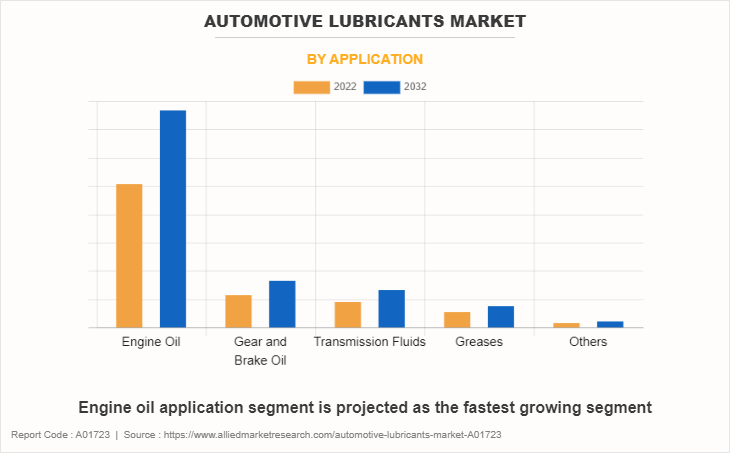
By application, the market is divided into engine oil, gear & brake oil, and transmission fluids. The engine oil segment is dominating the global market, in terms of revenue in 2022 with 65% share in the global market. In emerging economies, the expansion of vehicle fleets is significant. Countries like China and India have seen substantial growth in the number of vehicles on the road, contributing to increased demand for engine oil. Modern engines are designed for higher performance, efficiency, and emissions control.
These advancements have led to the development of specialized engine oils that meet the specific requirements of advanced engines, driving demand for more advanced lubricants. Stricter environmental regulations and emissions standards have encouraged the use of higher-quality engine oils that reduce friction and improve fuel efficiency. Many of these oils are synthetic or semi-synthetic, boosting their market growth.
The major companies profiled in this report include FUCHS, Indian Oil Corporation Limited, PetroChina Company Limited, Chevron Corporation, Exxon Mobil Corporation, TotalEnergies, BP p.l.c., Valvoline Inc., Royal Dutch Shell PLC.
Recent Key Strategies and Developments
• In June 2024, TotalEnergies introduced its innovative Quartz EV3R lubricant for passenger cars and the Rubia EV3R lubricant tailored for trucks. Both lubricant ranges are crafted from premium regenerated base oils and have received endorsements from numerous vehicle manufacturers.
• In September 2023, Liqui Moly GmbH introduced Dual Clutch Gear Oil 8100, designed for use in nearly all wet dual-clutch transmissions. This advanced formulation features a highly stable viscosity index, protective wear additives, and long-lasting friction modifiers, ensuring smooth and reliable shifting under all conditions.
Key Benefits For Stakeholders
- This report provides a quantitative analysis of the market segments, current trends, estimations, and dynamics of the automotive lubricants market analysis from 2022 to 2032 to identify the prevailing automotive lubricants market opportunities.
- The market research is offered along with information related to key drivers, restraints, and opportunities.
- Porter's five forces analysis highlights the potency of buyers and suppliers to enable stakeholders make profit-oriented business decisions and strengthen their supplier-buyer network.
- In-depth analysis of the automotive lubricants market segmentation assists to determine the prevailing market opportunities.
- Major countries in each region are mapped according to their revenue contribution to the global market.
- Market player positioning facilitates benchmarking and provides a clear understanding of the present position of the market players.
- The report includes the analysis of the regional as well as global automotive lubricants market trends, key players, market segments, application areas, and market growth strategies.
Automotive Lubricants Market Report Highlights
| Aspects | Details |
| Market Size By 2032 | USD 116.1 billion |
| Growth Rate | CAGR of 4.1% |
| Forecast period | 2022 - 2032 |
| Report Pages | 462 |
| By Base Oil |
|
| By Vehicle Type |
|
| By Application |
|
| By Region |
|
| Key Market Players | FUCHS, Valvoline Inc., BP p.l.c., Exxon Mobil Corporation, Indian Oil Corporation Limited, TotalEnergies, PetroChina Company Limited, Chevron Corporation, Royal Dutch Shell PLC |
Analyst Review
According to CXOs of leading companies, the global automotive lubricants market is expected to exhibit high growth potential. Automotive lubricants are extensively used for automotive parts, including body panels, chassis components, and other metal parts. The process provides a uniform and durable protective layer, helping to prevent corrosion and extend the lifespan of vehicles. Transportation and industrial equipment that require high strength, corrosion protection, and abrasion resistant properties can be accomplished with the use of automotive lubricants
In addition, automotive lubricants possess excellent significant properties such as high mechanical strength, adhesion to metals, thermal resistance, chemical resistance, and corrosion resistance that makes it best suited for transmission lubrication applications. CXOs further added that sustained economic growth and development of the automotive sector have increased the popularity of automotive lubricants.
Automotive lubricant is a specialized fluid designed to reduce friction and wear among moving parts in an automobile's engine and other mechanical components. These lubricants are essential for proper functioning and longevity of a vehicle's engine & various systems. Different types of automotive lubricants are available in the market such as engine oil, differential fluid, brake fluid, and others.
Asia-Pacific is the largest regional market for automotive lubricants market.
The automotive lubricants market is segmented on the basis of base oil, vehicle type, application, and region. By base oil, the market is categorized into mineral oil, synthetic, semisynthetic, and bio-based lubricants. On the basis of application, the market is classified into engine oil, gear & brake oil, transmission fluids, greases, and others. By vehicle type, it is divided into passenger cars, light commercial vehicles (LCVs), heavy commercial vehicles (HCVs), and others. Region-wise, the market is studied across North America, Europe, Asia-Pacific, and LAMEA.
Electronics and semiconductor industry is the leading application of automotive lubricants market.
FUCHS, Indian Oil Corporation Limited, PetroChina Company Limited, Chevron Corporation, Exxon Mobil Corporation, TotalEnergies, BP p.l.c., Valvoline Inc., Royal Dutch Shell PLC.
There has been a shift towards long-life lubricants that require less frequent changes, which can reduce maintenance costs and waste generation. This trend aligns with the desire for convenience and cost savings among consumers.
The Automotive Lubricants Market was valued for $77.8 billion in 2022 and is estimated to reach $116.1 billion by 2032, exhibiting a CAGR of 4.1% from 2023 to 2032.
Loading Table Of Content...
Loading Research Methodology...


